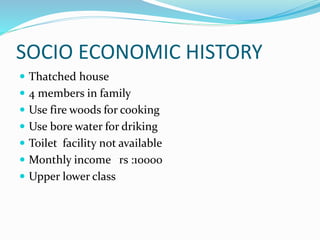This document contains the medical history of a 3-day old male neonate admitted with birth asphyxia and hyperbilirubinemia. It describes the mother's antenatal, natal and postnatal history. On examination, the neonate was found to have birth asphyxia with signs suggestive of hypoxic ischemic encephalopathy (HIE) stage 1 and physiological jaundice. The document discusses perinatal asphyxia, neonatal hypoxia, fetal monitoring techniques and recent advances in management of HIE including therapeutic hypothermia.




























































![Near Infrared Spectroscopy [NIRS]
Bedside and noninvasive technique
To moniter cerebral oxygenation stsus in HIE
Under evaluation](https://image.slidesharecdn.com/hie-220921155348-a57f5e28/85/HIE-pptx-61-320.jpg)








![ERYTHROPOIETIN[Epo]
Hematopoetic growth factor
Neuroprotective,Anti inflammatory and anti apoptotic
Safe dose -300 or 500 U/Kg every other day
Improves neurological outcome at 18 m in moderate
HIE](https://image.slidesharecdn.com/hie-220921155348-a57f5e28/85/HIE-pptx-70-320.jpg)





![Strategies under Consideration
Drugs – Indomethacin,Bumetanide,Sodium
cromoglycate,Minoclcline,Pomegranate polyphenols,2
–immunobiotin,necrostatin
Growth factors – Nerve GF,Insulin like GF 1,Brain
derived neurotrophic factor
Cord blood SCT –Immunomodulation,release of
growth factors,anti apoptotic mechanisms
Brain tonics [Piracetam] – widely used without any
scientific basis](https://image.slidesharecdn.com/hie-220921155348-a57f5e28/85/HIE-pptx-76-320.jpg)


